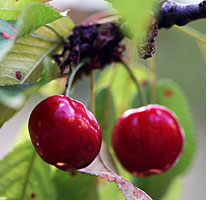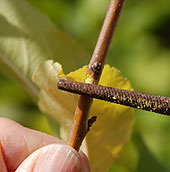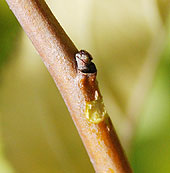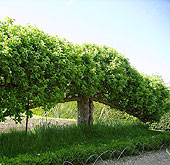
Notch Dormant Buds So They Bear Fruit
How to easily
speed up a tree that is slow to bear fruit

One great thing about fruit trees is that they are so completely
adaptable. If they aren't producing as much fruit as we would like, we
can trick them into performing better, and they never seem to mind.
In fact, they seem to do even better once we know what they can
tolerate and push them to do more. This month we are going to do just
that, get a fruit tree that may not be bearing fruit fast enough for
our tastes, and speed up the process.
What's interesting is that any
branch, regardless of its position on the tree, can be
made more fruitful by notching - an age-old technique that was
developed in Europe for intensive, espalier fruit culture.
The technique works by interrupting the flow of carbohydrates to a
dormant bud on a fruit tree, and by doing so, we can help it develop
into either a fruiting bud, or a leafy branch.
The entire process takes only a minute or two and then it's up to the
tree to get to work. So whether you want more fruit, or perhaps need a
leafy branch on a specific part of the tree for an espalier or other
purpose, the choice is up to you. Pretty cool I'd say!
Notching To Get A Fruit Bud
Some trees are slow, or even reluctant sometimes, to start producing
fruit. In fact sweet cherries are notorious for having long, bare
branches, that produce no fruit.
That's OK, because we can give them a nudge in the right direction. We
do this by selectively notching branches near buds.
Here's
How It's Done
1. This can be done during the late winter, through early summer.
2. Choose a one year old branch because eventually these buds along the
trunk and branches will die if they aren’t stimulated. So
it’s best to
do your notching on wood no older than one to two years.
3. Use a coarse 3/8 inch (1.9 cm) rat-tail file.
4. Stroke around half the diameter of the one year old branch about a
1/8 inch (3 mm) below a dormant bud.
5. Go deep enough so you can just see the white of the wood through the
green underbark.
6. That's it.
Why It
Works
By doing this, we are making a dormant bud develop into a fruiting bud
because by under-notching, we are interrupting the downward flow of
carbohydrates. The extra food (carbohydrates) then collects around the
bud and stimulates it to become a flower bud.
|
Choose a one year old branch
Use a coarse rat-tail file:

Under-notch about 1/8 inch (3 mm) below the dormant
bud:
Go deep enough to just see the white of the wood, and stroke around
half the diameter of the branch:

|
Notching To Get A Leafy Bud or New Branch
Do
the exact same steps as above, except this time, put the notch just
above a dormant bud. By doing this, we will induce a new branch
to develop which is a nice thing to know about if you need or
want a branch in a specific place on your tree or espalier.
Why It
Works
By over-notching, we are blocking the downward flow of
growth-regulating compounds that keep the side buds dormant. If less of
these compounds reach the bud, it can break dormancy and grow into a
shoot, and then a branch.
What's neat is that on the new branch that then develops in the next
year or so, you can then under-notch buds on that new branch to make it
more fruitful.
So the entire process encourages more growth, and then eventually more
fruit.
| Over-notch
just above
a dormant bud to develop a leaf bud or new branch:

Example of an espaliered fruit tree:

|
Conclusion
Notching to help intensify fruit production on trees is nothing new. It
has been going on for centuries in Europe.
The great thing about using these older techniques is that we know they
work, so there is no risk on our part to get it right.
Even better, is that today we are under no pressure to do these things.
Unlike some gardeners a long time ago who had to make these techniques
work because they had royalty and other high placed persons to keep
happy, we can do them simply for the fun of it - and I encourage you to
do so! |  |
Hilary
Rinaldi is a member of the National Garden Writers Association, a
nationally published writer, and a certified organic grower. She
regularly speaks and writes about all gardening related topics, with an
emphasis on making gardening a successful and enjoyable process for
anyone who wants to learn. Weekend Gardener Monthly Web Magazine
concentrates of giving detailed gardening tips and gardening advice to
all levels of gardeners.
Back to
Planting
and Growing Page
Propagation
Page
|








